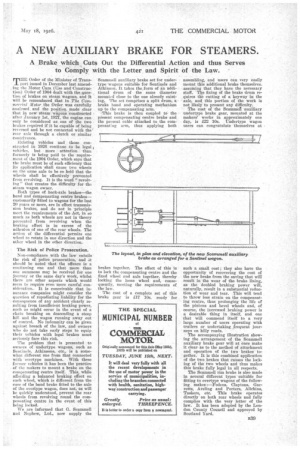A NEW AUXILIARY BRAKE FOR STEAMERS.
Page 21

If you've noticed an error in this article please click here to report it so we can fix it.
A Brake which Cuts Out the Differential Action and thus Serves to Comply with the Letter and Spirit of the Law.
THE Order of the Minister of Transport issued in December last amending the Motor Cars. (Use and 'Construeflop.) Order of 1904 dealt with the question of brakes on steam Wagons; and It • will he remembered that in The Corn.: wierciAl Motor, the Order was carefully , analysed, and the position_ made clear that in new steam wagons .constructed after January 1st, 1927, the engine can only be considered as one of the two brakes required if it be capable of being , reversed and be not connected with the rear axle through a clutch or similar contrivance.
Existing vehicles and those constructed in 1926 continue to be legali vehicles, but more attention than formerly is being paid to the requirement of the 1904 Order, which says that the brake must be of such efficiency that Its application -shall cause two wheels on the same axle to be so held that the wheels shall be effectively prevented from revolving. It is the word " revolving " that creates the difficulty for the steam wagon owner.
Both types of back-axle brakes—the band and compensating centre brakes— customarily fitted to wagons for the last 20 years or more, are in effect transmission brakes, and do not in .principle meet the requirements of the Act, in so mulch as both wheels are not in theory prevented from revolving when the braking effect is in excess of the adhesion of one of the rear wheels. The action of the differential permits one vibeel to rotate in one direction and the other wheel in the other direction.
The Risk of Police Prosecution.
Non-compliance with the law entails the risk of police prosecution, and it should be noted that the offence is a continuing one and that more than one summons may be received for one journey or the same day's work, whilst there are other aspects which would seem to require even more careful consideration. It is conceivable that insurance companies might consider the question of repudiating liability for the consequence of any accident clearly resulting from insufficient braking power, such as might occur in the event of a chain breaking on descending a steep hill and the wagon running away out of control. No indemnity can be given against breach of the law, and owners who do not take early steps to equip their vehicles with legal brakes must seriously face this risk.
The problem that is presented to owners of undertype wagons, such as Sentinels, Atkinsons, etc., is a somewhar different one from that connected with overtype machines. With these former vehicles it has been the practice of the makers to mount a brake on the compensating centre itself. This, while affording a balanced braking effect 011 each wheel, which is different from the case of the band brake fitted to the axle of the overtype wagon, does not, as will be quickly understood, prevent the rear wheels from revolving round the compensating centre in the event of this being locked.
We are informed that G. Scammell and Nephew, Ltd., now supply the Scammell auxiliary brake set for undertype wagons suitable for Sentinels and Atkinson. It takes the form of an additional drum of the same diameter mounted close to the one already existing. The set comprises a split drum, a brake band and operating mechanism up to the compensating arm.
This brake is then coupled to the present compensating centre brake and the present cable attached to the compensating arm, thus applying both brakes together. The effect of this is to lock the compensating centre and the fixed wheel and axle together, thereby locking the loose wheel and, consequently, meeting the requirements of the law.
The cost of a complete set of this brake gear is £17 10s. ready for THE SPECIAL
assembling, and users can very easily mount this additional brake themselves. assuming that they have the necessary staff. The fixing of the brake drum requires th-e cutting of a keyway in the axle, and this portion of the work is not likely to present any difficulty.
The cost of the Scammel auxiliary undertype brake gear, mounted at the makers' works in approximately one day, is £22 10s. Undertype wagon users can congratulate themselves at such a small cost ; they also have the opportunity of recovering the cost of the new brake from the saving that will result in the wear of the brake lining, as the doubled braking power will, naturally, result in a substantial reduction of wear and tear. This will tend to throw less strain on the compensating centre, thus prolonging the life of the pinions and bevel wheels and, of course, the increased braking power is a desirable thing in itself, and one that will commend itself to a very large number of users operating with trailers or undertaking frequent journeys on hilly roads.
The accompanying illustration showing the arrangement of the Scammell auxiliary brake gear will at once make it clear as to the method of attachment and operation of the two brakes together. It is this combined application of the two brakes that causes the locking of the two wheels and thus makes this brake fully legal in all respects.
The Scammell rim brake is also made in several different types suitable for fitting to overtype wagons of the following makes :—Podens, Claytons, Garretts, Aveling and Porters, Allchins, Taskers, etc. This brake operates directly on both rear wheels and fully complies with the very letter of the law. It has been adopted by the London County Council and approved by Scotland Yard.


























